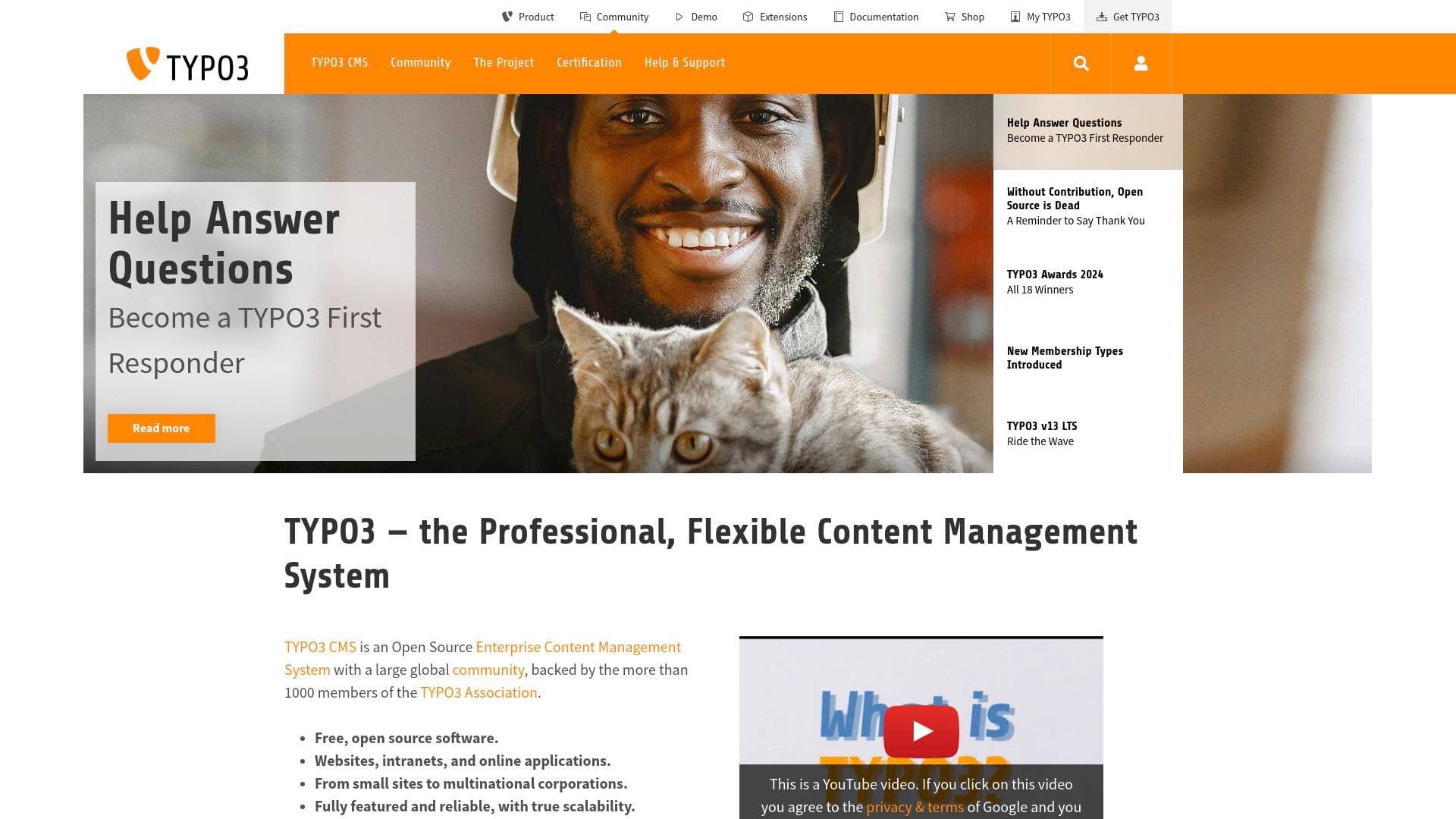TYPO3
TYPO3 is a free, open-source enterprise CMS for creating scalable websites, intranets, and applications for organizations of all sizes.

Brief Overview of TYPO3
TYPO3 is an open-source Enterprise Content Management System built on PHP, designed to provide a reliable and scalable foundation for digital projects. The platform serves as a comprehensive solution for creating and managing a wide range of digital properties, including public websites, corporate intranets, and custom online applications. Its core architecture is engineered for true scalability, making it suitable for projects ranging from small websites to the complex digital ecosystems of multinational corporations. A key differentiator is its inherent support for managing multiple sites and multiple languages from a single installation. The entire project is backed by the TYPO3 Association, which has over 1,000 members, and is supported by a large global community of developers, designers, and content professionals who contribute to its ongoing development and security.
TYPO3 Key Features for Content Creators
-
Smart Content Management: The system provides tools for creating and delivering content across various digital channels. It includes features for content planning, modeling, and authoring workflows, as well as a Digital Asset Management (DAM) system and built-in SEO capabilities.
-
Massively Multisite and Multilingual: A core strength of TYPO3 is its ability to manage an unlimited number of websites and content languages within a single installation. This centralized approach is ideal for global organizations that need to maintain consistent branding and content across different regions and languages.
-
Digital Marketing Enabled: The platform is designed to integrate with a wide array of digital marketing tools. This allows marketing teams to connect their preferred analytics, automation, and campaign management software directly into the CMS to deliver consistent brand messaging.
-
Open, Extensible, and Customizable: As an open-source platform, TYPO3 offers significant freedom and flexibility. Developers can build highly customized projects tailored to specific needs without being locked into a proprietary system, ensuring the platform can evolve with future requirements.
-
Professional Open Source Model: TYPO3 combines the benefits of open-source technology with the reliability of enterprise-level vendor support. It is sustained by a vibrant professional community and a commercial ecosystem, offering a balance of flexibility and professional backing.
-
Universal Frontend User Experience: The CMS is capable of delivering content to any device or channel. It supports the creation of traditional websites, headless web services for native applications, and other engaging, accessible user experiences.
-
Secure, Performant, and Scalable: The system is engineered to create information-rich digital properties that load quickly and perform reliably, even at a large scale. Security and user privacy are incorporated into its design from the ground up.
-
Free and Open Source: TYPO3 CMS is published under the GPL license, meaning there are no fees for using the software. Anyone can use and contribute to the improvement of the content management system.
TYPO3 Target Users & Use Cases
TYPO3 is designed for a diverse group of professional users, including IT teams, marketing departments, developers, editors, designers, and content strategists. Its enterprise-class features suggest it is best suited for users with a degree of technical knowledge or those working within a structured team environment. The platform's capabilities are geared towards medium to large organizations and multinational corporations that require robust, scalable solutions.
Specific use cases include:
- Managing a global corporation's portfolio of country-specific websites from a single backend.
- Operating a multilingual e-commerce platform with localized content.
- Building and maintaining a secure corporate intranet for internal communications.
- Developing custom, data-driven web applications.
- Creating a central content hub that delivers information to both a public website and native mobile apps via a headless architecture.
- Integrating a full suite of marketing automation and analytics tools for targeted campaigns.
- Powering high-traffic, information-rich websites that require fast performance and high security.
Frequently Asked Questions About TYPO3
Is TYPO3 free to use? Yes, TYPO3 CMS is free software published under the GPL license. There are no fees required to use the platform for any project.
What technology is TYPO3 built on? TYPO3 is an enterprise-class Content Management System that is based on the PHP programming language.
Who is behind the development of TYPO3? The TYPO3 Association, a not-for-profit organization with more than 1,000 members, coordinates and funds the long-term development of the TYPO3 CMS platform. It is also supported by a large global community.
Can TYPO3 manage multiple websites? Yes, the platform offers superior support for multisite and multilingual installations. It allows users to manage an unlimited number of websites and content languages from within a single installation.
What types of projects is TYPO3 suitable for? TYPO3 is designed for a broad range of projects, including websites, intranets, and online applications. It is built to scale from small sites to the extensive digital needs of multinational corporations.
Bottom Line: Should Content Creators Choose TYPO3?
TYPO3 is a strong choice for organizations and professional teams seeking an enterprise-grade, open-source CMS. Its primary advantages lie in its powerful multisite and multilingual capabilities, making it exceptionally well-suited for global companies managing complex digital presences across different regions. The platform's scalability ensures it can handle projects from simple websites to large-scale, high-traffic applications without compromising performance.
Marketing and IT teams will find its ability to integrate with other digital marketing tools and its extensible architecture highly valuable for creating customized solutions. While its feature set is robust, it is best leveraged by teams with access to development resources to fully capitalize on its flexibility. For businesses that require a reliable, secure, and professional open-source solution to build and manage sophisticated digital experiences, TYPO3 presents a compelling and powerful option.
